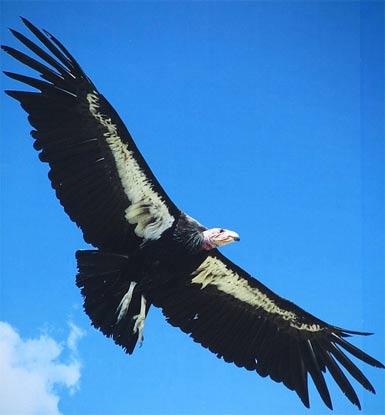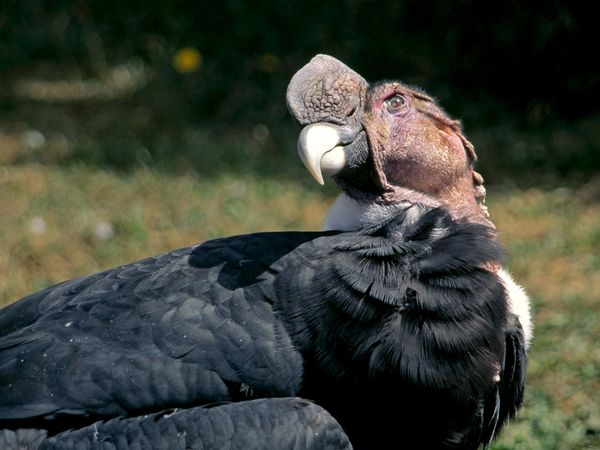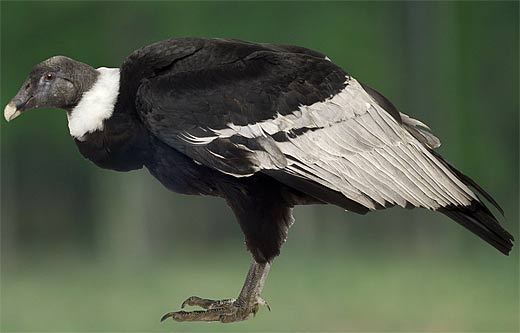
Vultur gryphus
SUBFAMILY
Catharnae
TAXONOMY
Vultur gryphus Linneaus, 1758, Chile. Monotypic.
OTHER COMMON NAMES
French: Condor des Andes; German: Andenkondor; Spanish:
Cуndor Andino.
PHYSICAL CHARACTERISTICS
39–51 in (100–130 cm) 18.1–23.1 lb (8.2–10.5 kg). with a
wingspan of as much as 10 ft (3 m). Black plumage with large
white patches on the dorsal portion of the wings. Neck ruff of
short white feathers. Sexually dimorphic with males exhibiting
a large fleshy crest, tan-colored irises, and head skin ranging
from dark gray to yellow. Females have red irises, grayish skin
on their head, and can be 2.2–11 lb (1–5 kg) lighter.
DISTRIBUTION
Andes Mountains from Venezuela to Tierra del Fuego, ranging
to the coast from northern Peru to southern Chile and
Argentina.
HABITAT
Roosting and nesting occur in mountainous areas where winds
allow the birds to range widely. Foraging occurs in open areas
of savanna, grasslands, deserts, and beaches along the coast.
BEHAVIOR
Highly curious and intelligent, it finds food through observing
the
BEHAVIOR
s and activities of other species. Condors can
travel hundreds of miles in a single day, foraging alone or in
well dispersed groups at high altitudes. Strict hierarchy at a
carcass reduces aggression to a minimum. At Andean condor
roosts in South America, groups consisting of several immature
birds seem to gain the same information advantage as in
the black vulture system. In areas where large roosts are not
convenient, however, juvenile bands move between territory
pairs led by the older more experienced individuals of the
group. Their brown, immature stage plumages, which gradually
change to black and white by seven years of age, afford
them safe passage between nesting cliffs defended against
adults and gain them the advantages of associating with
knowledgeable adult birds.
FEEDING ECOLOGY AND DIET
Scavenger of large carcasses that include marine mammals as
well as wild and domestic ungulates. Have been known to feed
on sea bird nestlings on offshore guano islands. Their large
and powerful bills enable them to tear open thick hide.
REPRODUCTIVE BIOLOGY
Courtship displays have been seen throughout the year near
the equator. To the far south nesting occurs from May
through August. Incubation from 58 to 62 days (captive) and
fledging takes about six months. While pairs may hold territories,
nesting may occur every other year and may be postponed
for several years if food availability is low. Parental dependency
period is lengthy and may vary with food supply.
CONSERVATION STATUS
Listed as Near Threatened but still abundant in the Chile/
Argentina Andes where thousands of birds exist. Fewer birds as
one progresses north along the Andes until Colombia and
Venezuela where the population consists of mostly reintroduced
birds.
SIGNIFICANCE TO HUMANS
Pictographs and legends found throughout native cultures.
“The sun rose and set by the wings of the condor,” according
to an Inca belief. Festivals and rituals involving this species still
exist. A modern Andean festival involves tying a condor to a
bull’s back and sending the bull running through the town. If
the condor survives, it symbolizes the successful resistance of
the native South Americans against the Spanish conquistadors,
and it is released back to the wild.
Photo Gallery of - Andean condor




 Animalia Life
Animalia Life